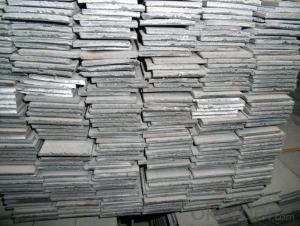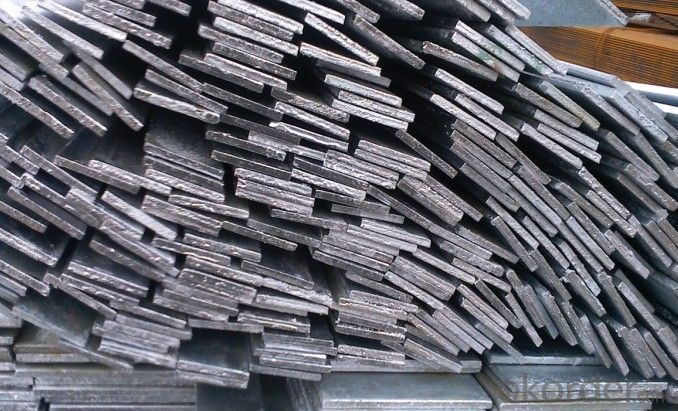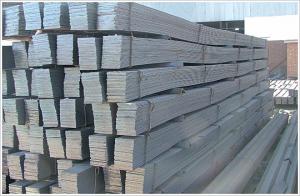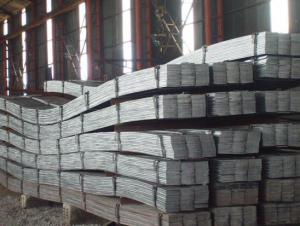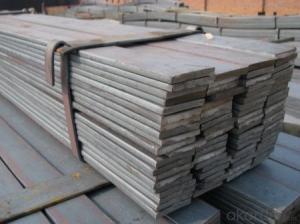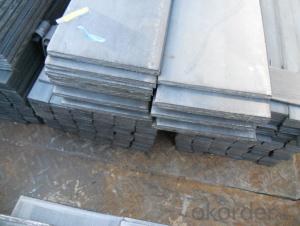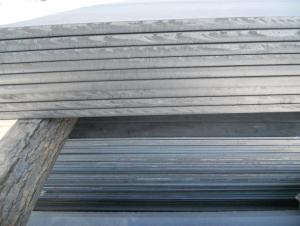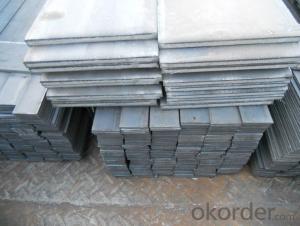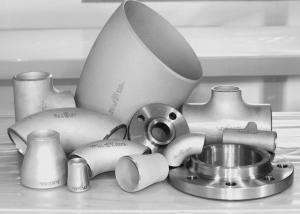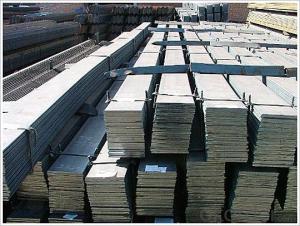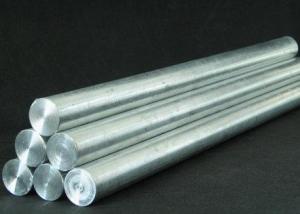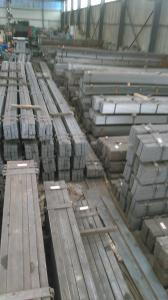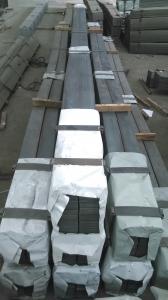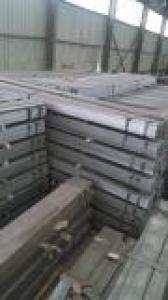Steel flat bars; Flat steel
- Loading Port:
- Tianjin
- Payment Terms:
- TT OR LC
- Min Order Qty:
- 2000 m.t.
- Supply Capability:
- 10000 m.t./month
OKorder Service Pledge
OKorder Financial Service
You Might Also Like
Product Description:
Production Flow of STEEL FLAT SS400
The steel flat bar is made through three processes:
1.Feeding the material: Feeding the row material (the steel plate) to Slitting Line.
2.Slitting:The steel plate would be slitted into expected width by lengthways cutter.
3. Leveled and cutting: The plat bar would be ground into level by the grinder and then cut into required length
Tangshan flat bar processing plant
Our factory was founded in 2008, has been formed steel processing, trade, distribution, haihe river transportation and information service in the integration of modern company, the headquarters is located in the national steel rich district of tangshan city, hebei province, the first big province, covers an area of 20 mu, is apart from the beijing-shenyang high-speed 0.5 kilometers tangshan north exit, the geographical position is superior, the traffic is convenient.
The company owns the most advanced domestic shear steel equipment, plasma cutting equipment, can according to customer demand for steel plate kaiping, slitting, crosscutting, shear and winding and other personalized processing services, enable customers to save steel cut expenses and losses, greatly reduce the production cost, improve production efficiency. Its main products are steel billet, steel strip, flange plate and web plate, flat steel, open the tablet, etc.
Products applied to the export of flat steel, steel structure, steel plate, cars, ships, cement, steel girder plate socket, machinery manufacturing, bridge template, and other industries. Processing width: 10 mm - 1250 mm, the thickness of 1.5 mm - 16 mm, the length can be due to the needs of customers, annual processing capacity of 100000 tons. Product quality in line with the GB/T 709-2006carbon structure and hot rolled steel plate and strip of low alloy structure" of the relevant requirements.
In the increasingly market competition, the company in good faith integrity, mutual benefit and win-win principle sincerely look forward to cooperating with you!
Product description:
Processing capacity: 100000 tons/year; Slitting precision (width) : 0.5 mm or less
Raw material: Q235B, Q345B, Q235-1 b crosscutting precision (length) : 2 mm or less
Processing: the thickness of 2.0-16 mm; Shear length: 2000 mm above
Wide degree: 15-1250 - mm; Leveling precision: 1-2 MMM squared
- Q: Can steel flat bars be used for manufacturing aerospace components?
- Indeed, aerospace components can be manufactured using steel flat bars. Steel, known for its exceptional strength, durability, and corrosion resistance, holds a prominent position in the aerospace manufacturing realm. With the added advantage of easy machinability and versatility in shape and size, steel flat bars prove ideal for crafting diverse aerospace components, including brackets, supports, frames, and structural elements. Moreover, their employment guarantees the necessary strength and stability indispensable in aerospace applications, guaranteeing the safety and reliability of the resulting components.
- Q: What is the negative deviation allowed by the national standard for galvanized flat steel of 40*4?
- 40 is the width of the section steel, 4 is the thickness of the steel, and the unit is mm.Flat, refers to the width 12-300mm, thickness 4-60mm, cross section is rectangular in shape and with a blunt edge of steel. Flat steel can be finished steel, or can be used as the blank of welded pipe and thin slab for laminated sheet rolling.
- Q: What are the different specifications for steel flat bars?
- Steel flat bars are available in a variety of specifications that determine their size, shape, and composition. These specifications encompass dimensions, such as width, thickness, and length, as well as the type of steel utilized and any additional properties. Dimensions for steel flat bars exhibit considerable variation. Widths commonly range from 1/2 inch to 12 inches, while thicknesses can span from 1/8 inch to several inches. Lengths are typically denoted in feet or meters, with standard lengths, such as 6 or 12 feet, readily accessible, or customized lengths tailored to the desired dimensions. The type of steel employed in flat bars also displays diversity. Carbon steel, a fundamental and versatile choice, and stainless steel, which offers resistance against corrosion and presents an appealing aesthetic, are the most prevalent types. Carbon steel flat bars are further categorized based on their carbon content, with low-carbon, medium-carbon, and high-carbon steel constituting widely available options. Moreover, steel flat bars can possess supplementary properties based on their intended utilization. For instance, certain flat bars may undergo heat treatment to augment their strength or hardness, while others may undergo galvanization or coating to heighten their resistance to corrosion. It is important to note that different countries and industries may adhere to their own distinct standards or specifications for steel flat bars. These standards, such as ASTM (American Society for Testing and Materials) or EN (European Norms), ensure consistency and quality across various manufacturers and applications. Consequently, it is crucial to consider these standards and specifications when selecting steel flat bars for a specific project or application.
- Q: Can steel flat bars be customized in terms of size and shape?
- Yes, steel flat bars can be customized in terms of size and shape. They can be cut and shaped according to specific dimensions and requirements to meet the desired specifications for various applications.
- Q: Are steel flat bars galvanized?
- Steel flat bars can be galvanized, but not all steel flat bars are galvanized. Galvanization is a process of applying a protective zinc coating to steel in order to prevent corrosion. The galvanization process involves immersing the steel flat bar in a bath of molten zinc, which forms a thin layer of zinc on the surface of the steel. This layer provides excellent corrosion resistance and extends the lifespan of the steel flat bar. However, it is important to note that not all steel flat bars are galvanized. Some may be left untreated or may have other types of coatings or finishes applied to them, depending on the specific application or customer requirements. Therefore, it is necessary to check the product specifications or consult with the manufacturer or supplier to determine whether a particular steel flat bar is galvanized or not.
- Q: Can steel flat bars be used for making staircases?
- Absolutely, staircases can indeed be constructed using steel flat bars. The strength and durability of steel flat bars make them a popular choice in the fields of construction and fabrication. They serve as an excellent primary structural element for staircases, ensuring reliable support and stability. Moreover, steel flat bars can be effortlessly manipulated and joined through welding to achieve the desired staircase design. Their corrosion resistance further enhances their suitability for indoor as well as outdoor staircases. All in all, steel flat bars offer versatility and dependability when it comes to staircase construction.
- Q: How long do steel flat bars typically last?
- Due to their durability and resistance to corrosion, steel flat bars are known to have a long lifespan. However, the length of time they last is contingent upon the conditions they are exposed to and the level of maintenance they receive. When properly cared for and shielded from moisture and harsh elements, steel flat bars can endure for many decades, or even longer. Conversely, if they are exposed to corrosive environments or neglected in terms of upkeep, their lifespan may be significantly diminished. Furthermore, the quality of the steel, the specific alloy used, and the amount of load or stress the flat bars experience can also impact their longevity. Therefore, it is crucial to conduct regular inspections and maintenance on steel flat bars to ensure they reach their optimal lifespan and performance.
- Q: Do steel flat bars have a specific yield strength?
- Yes, steel flat bars have a specific yield strength. The yield strength of a steel flat bar refers to the amount of stress it can withstand before it starts to deform permanently. This property is typically specified by manufacturers and can vary depending on the type and grade of steel used.
- Q: How do you protect steel flat bars from chemical corrosion?
- There are several effective methods that can be utilized to safeguard steel flat bars from chemical corrosion. 1. Coating: To prevent chemical corrosion, it is common practice to apply a protective coating. There are numerous coating options available, including paint, epoxy, enamel, and polyurethane. These coatings act as a barrier between the steel surface and corrosive chemicals, thus reducing the risk of direct contact and subsequent corrosion. It is crucial to select a coating specifically designed for chemical resistance and ensure proper application for maximum effectiveness. 2. Galvanization: Another method to protect steel flat bars from chemical corrosion is through galvanization. This process involves applying a layer of zinc to the surface, creating a protective barrier against corrosive substances. Hot-dip galvanization is a widely used technique where the steel is immersed in molten zinc, resulting in a durable and thick coating. Galvanized steel flat bars exhibit high resistance to chemical corrosion and offer long-lasting protection. 3. Stainless steel: Incorporating stainless steel flat bars with a high chromium and nickel content can significantly enhance their resistance to chemical corrosion. The inclusion of these elements forms a passive layer on the surface, acting as a protective barrier against corrosive chemicals. Stainless steel is particularly suitable for applications where exposure to aggressive chemicals is anticipated. 4. Proper storage and handling: Proper storage and handling practices are crucial in safeguarding steel flat bars from chemical corrosion. Storing them in a dry and well-ventilated area, away from corrosive substances, can prevent direct exposure. Additionally, using protective covers or wrapping the bars in moisture-resistant materials can provide an additional layer of defense. Regular inspection and maintenance are also essential to promptly identify any signs of corrosion. If any damage or deterioration is detected, timely repairs or replacements should be carried out to maintain the integrity and longevity of the steel flat bars.
- Q: Can steel flat bars be used for electrical or grounding applications?
- No, steel flat bars are not typically used for electrical or grounding applications. This is because steel is a conductor of electricity, and using it for electrical or grounding purposes can pose safety risks. In these applications, materials like copper or aluminum are commonly used due to their excellent electrical conductivity and low resistance. These materials are specifically designed to handle the high currents and provide efficient electrical conductivity, while also being able to dissipate any excess heat generated during operation. Therefore, it is recommended to use materials specifically designed for electrical or grounding applications rather than steel flat bars.
Send your message to us
Steel flat bars; Flat steel
- Loading Port:
- Tianjin
- Payment Terms:
- TT OR LC
- Min Order Qty:
- 2000 m.t.
- Supply Capability:
- 10000 m.t./month
OKorder Service Pledge
OKorder Financial Service
Similar products
Hot products
Hot Searches
Related keywords
